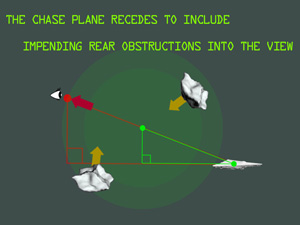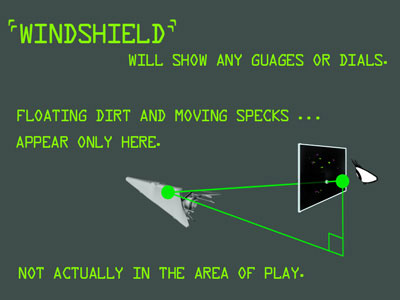

Designed and created to demonstrate my coding and artistic flexibilities for various platforms.
What a sight....wish you were here.
“ A view to kill with... ”

The game is a third person shooter, but the player's view is more in the line of a chase plane perspective; the view is not rigidly fix to the ship, but react as though flying behind.
The normal or ideal position is about 30 degree above and two, or so, ship length distance.
Some of the crucial aspects of the chase plane view: automatic avoidance of possible collision by passing objects, prevent views outside the play field and the most important is the latency component.
The latency imbues a lag that dampens the view of any extreme quick maneuvers by the ship (smooth the possible jerkiness). The chase view will strive to it's ideal position but in a sweeping graceful manner; this gives a feel of inertia to the chase plane view.



Particles, particles....the spice of life.
“ Pretty lights, explosion ... and a dirty windshield. ”
The judicial use of particles effects helps to liven up the static models without making it into a glitter show. Applied particles can become beaconing signal lights on the ship or as drifting space flotsom, they all adds to a dynamic sense of "atmosphere" to the dead of space.



Some examples of particles being applied, though not necessary for any functional reasons but enhances the esthetics.

But some effects are necessary for play.
In space there is no frame of references for orientation and speed, especially with tumbling rocks moving in different directions. With the chase plane view at the normal position combine with the twisting manueverability of the ship, any forward momentum may not be easily determined by just observing the ship.
So one of the effects to convey this motion, is the use of streamers from the tips of the wings. The length would denote the speed and the orientation of the true direction of forward momentum.

The explosions are composites of simple semi-tranlucent orbs and particle effects. The sequence of the event are quick, no lingering drawnout detonation but a couple of seconds with the particles lasting longer.
The asteroids can only be destroyed by cannon fire or alien impacts. Asteroid to asteroid contact just have them bounce off each other.
The division from large to the smaller rocks are by rule of thumb, no calculating complex geometry or precise angles to the tenth decimal required; it's quick and dirty (non-scientifically accurate) routines, not rocket science at all.

The instrumentations are kept to a minimum (no radars) to keep the focus on the external action. Dynamic space dusts, wispy debris and glare effects are manifested on this windshield.

These dust particles effect also aid in the sense of direction.